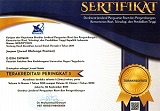Kelas Olahraga Sebagai Upaya Pembinaan Prestasi yang Berkelanjutan
DOI:
https://doi.org/10.21831/jorpres.v18i3.51609Keywords:
pembinaan, kelas olahraga, prestasiAbstract
Pembinaan adalah bagian penting dari proses keberlangsungan mempertahankan prestasi. Dalam upaya pembinaan atlet terdapat tahapan konteks, input, proses dan hasil yang menjadi bagian evalusai agar dapat mencapai hasil yang diharapkan. Penelitian ini bertujuan untuk mengetahui hasil pembinaan prestasi dan evaluasi pada bimbinaan prestasi kelas olahraga. Metode yang digunakan dalam artikel ini adalah metode campuran dengan sampel uji coba 108 siswa dan 13 guru pada lima Sekolah Menengah Atas yang berada di wilayah berbeda. Hasil dari penelitian ini menunjukkan rerata 3,20 "cukup baik" pada siswa dan 13 guru menunjukkan hasil "cukup baik" dengan rerata 3,25.
References
Biro Humas dan Hukum Kemenegpora. (2007). Undang-undang Republik Indonesia No. 3 Tahun 2005 tentang Sistem Keolahragaan Nasional. Jakarta: Kemenegpora
Bocarro, J. N., Kanters, M,A,., Cerin, E., Floyd, M. F., Casper, J, M,. Suau, L,. & McKenzie, T, L,. 2012. School sport policy and school-based physical activity environments and their association with observed physical activity in middle school children. Health and Place. Volume 18, Issue 1, 31-38. ISSN: 1353-8292.
Creswell, J, W. 2010. Research Design Pendekatan Kualitatif, Kuantitatif, dan Mixed. Yogyakarta: Pustaka Pelajar.
Donald, B. Y., Lyn, M. S., Rodney, K. H., & Flora, A. C. 2011. The program evaluation standars. United State of America: Sage pubplications.
McCullick, B, A. 2016. An Analysis of National Football League Coaching Trees And The Network They Comprise. International Journal of Sports Science & Coaching. Vol. 11 Issue 1, 4–15. DOI: 10.1177/1747954115624814.
Moleong, L, J. 2002. Metodologi Penelitian Kualitatif. Bandung: PT.remaja Rosdakarya.
Myer, G, D., Jayanthi, N., dan DiFiori, K, P. 2015. Sports Specialization, Part II: Alternative Solutions to Early Sport Specialization in Youth Athletes. Sports Health, Vol. 8 Issue 1, 65-73.
Pitts, B. 2014. A Content Analysis of the European Sport Management Quarterly and its Predecessor. The European Journal for Sport Management. Vol. 10, Issue 2, 1984-2012.
Ralph, T. 2010. Models of teaching, New Yersey: Prentice-Hall, Inc. Englewood Cliffs.
Stufflebeam, D, L. & Shinkfield, A, J. 2009. Evaluation theory, models, and applications, san francisco: A Wiley Imprint. Journal of Multi Disciplinary Evaluation. Volume 6, Number 11. ISSN 1556-8180.
Unesco. 2020. Values Education through Sport. 18 June 2020. https://en.unesco.org/themes/sport-and-anti-doping/ sports-values-education
Wang, J. & Straub, W, F. 2012. An Investigation into the coaching approach of a successful world class soccer coach: anson dorrance. International Journal of Sports Science & Coaching. Volume 7 Number 3, 431-446.
Zhang, G., Zeller, N., Griffith, R., Metcalf, D., Williams, J., Shea, C & Katherine, M. 2011. Using the context, input, process, and product evaluation model (CIPP) as a Comprehensive Framework to Guide the Planning, Implementation, and Assessment of Service-learning Programs. Journal of Higher Education Outreach and Engagement. Volume 15, Number 4, 57-84. ISSN 1534-6104.
Lyle, John. 1997. Managing Excellence in Sport Performance. United Kingdom: MCB University Press.
Hays, Thomas, Maynard, dan Bawden. 2009. The Role of Confidence in World-Class Sport Performance. United Kingdom: Routledge Taylor and Francis Group.
Melnick, M. J., Sabo, D. F., dan Vanfossen, B. 1992. Educational effects of interscholastic athletic participation on African-American and Hispanic youth. Adolescence, 27(106), 295-308.
Rasmussen, K. 2000. The changing sports scene. Educational Leadership, 57(4), 26-29.
Casey, A. C. 1989. Academic intramurals: The thrill of victory--The excitement of competition. (ERIC Document Reproduction Service No. ED322574)
Kavussanu, M., dan McAuley, E. 1995. Exercise and optimism: Are highly active individuals more optimistic? Journal of Sport and Exercise Psychology, 17, 246-248.
Downloads
Published
How to Cite
Issue
Section
License
Authors who publish with this journal agree to the following terms:
- Authors retain copyright and grant the journal right of first publication with the work simultaneously licensed under a Creative Commons Attribution License that allows others to share the work with an acknowledgement of the work's authorship and initial publication in this journal.
- Authors are able to enter into separate, additional contractual arrangements for the non-exclusive distribution of the journal's published version of the work (e.g., post it to an institutional repository or publish it in a book), with an acknowledgement of its initial publication in this journal.
- Authors are permitted and encouraged to post their work online (e.g., in institutional repositories or on their website) prior to and during the submission process, as it can lead to productive exchanges, as well as earlier and greater citation of published work (See The Effect of Open Access).




